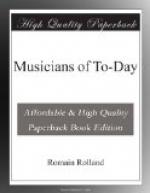[Footnote 163: In his criticisms his heart is not always in agreement with his mind. His mind denounces the Renaissance, but his instinct obliges him to appreciate the great Florentine painters of the Renaissance and the musicians of the sixteenth century. He only gets out of the difficulty by the most extraordinary compromises, by saying that Ghirlandajo and Filippo Lippi were Gothic, or by stating that the Renaissance in music did not begin till the seventeenth century! (Cours de Composition, pp. 214 and 216.)]
Of course his nature is too dignified to let the quarrel be shown openly. His heart obeys the commands of his reason, or compromises with it, and by seeming respectful of authority saves appearances. His reason, represented here by the poet, likes simple, realistic, and relevant action, together with moral or even religious teaching. His heart, represented by the musician, is romantic; and if he followed it altogether he would wander off to any subject that enabled him to indulge in his love of the picturesque, such as the descriptive symphony, or even the old form of opera.
For myself, I am in sympathy with his heart; and I find his heart is in the right, and his reason in the wrong. There is nothing that M. d’Indy has made more his own than the art of painting landscapes in music. There is one page in Fervaal at the beginning of Act II which calls up misty mountain tops covered with pine forests; there is another page in L’Etranger where one sees strange lights glimmering on the sea while a storm is brooding.[164] I should like to see M. d’Indy give himself up freely, in spite of all theories, to this descriptive lyricism, in which he so excels; or I wish at least he would seek inspiration in a subject where both his religious beliefs and his imagination could find satisfaction: a subject such as one of the beautiful episodes of the Golden Legend, or the one which L’Etranger itself recalls—the romantic voyage of the Magdalen in Provence. But it is foolish to wish an artist to do anything but the thing he likes; he is the best judge of what pleases him.
[Footnote 164: Act III, scene 3. The power of that evocation is so strong that it carries the poet along with it. It would seem that part of the action had only been conceived with a view to the final effect of the sudden colouring of the waves.]
* * * * *




